Displaying a YouTube playlist on your WordPress site: step-by-step

Are you looking for a way to display YouTube playlists on your WordPress site? Then, you’ve landed on the right page! In this detailed guide, I’ll lay down a step-by-step tutorial on easily creating a searchable and filterable YouTube library on your WordPress website. We'll do it with the best WordPress Youtube playlist plugin.
Uploading and publishing videos on YouTube is undoubtedly the right choice. You get to host your videos for free and leverage the reach of the second most popular search engine right after Google.
While hosting your videos on YouTube is the way to go, there might be scenarios where you need to display those videos or even playlists on your WordPress site. For that, we’ve created this step-by-step guide to help you display your YouTube videos and playlists on your website with a WordPress YouTube plugin.
Keep reading to follow our written tutorial, or watch this video:
By the end of this tutorial, you'll be able to embed a video hosted on YouTube on your WordPress website and create a searchable and filterable playlist with the Posts Table Pro plugin:
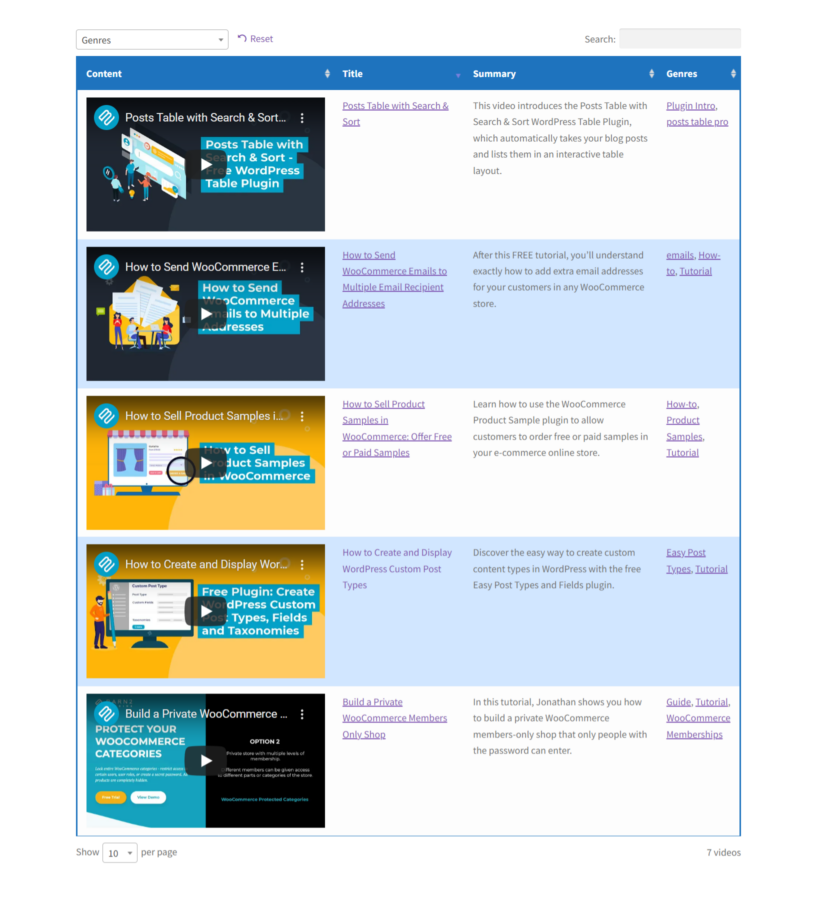
Why display a YouTube playlist in WordPress?
While hosting your videos on YouTube is the ideal choice, there are many scenarios where adding them to your website makes sense.
- If you have more high-quality traffic coming from your website, embedding a playlist can help you retain traffic.
- Since videos are more engaging, it helps in boosting SEO by reducing the bounce rate and increasing on-page engagement.
- It helps you promote your YouTube channel and get more subscribers.
All this can be achieved by adding videos individually, so why display a YouTube playlist?
Adding a playlist can lead your visitors in the right direction. You can keep the videos focused on a single topic, and it helps you guide your viewers from one video to another.
And since the videos are embedded on your website, you can add filters, search, and sorting options to improve the video navigation. This can help the users find their desired videos easily and thus helps in reducing the bounce rate. In this tutorial, we’ll use the Posts Table Pro plugin to add a YouTube playlist with the features mentioned above.
Why Posts Table Pro is the best WordPress YouTube playlist plugin
YouTube comes with its own option to create a playlist by adding individual videos in that specific playlist from the creator studio.
Although this is the default way, a few limitations make this alternative less efficient.

This is what the YouTube video playlist and the YouTube player look like after adding embedding it using the iframe code:

To make the YouTube playlist actually usable on your website, you need to use a WordPress YouTube playlist plugin.
How to create a YouTube playlist on your website
In this section, I'll take you through a step-by-step guide to help set up a sortable YouTube playlist on your website.
Here's what we'll be doing:
- Create a post type to store your YouTube videos and playlists using Easy Post Types and Fields.
- Group them using taxonomies (if required).
- Display them in a searchable table using Posts Table Pro.
Let's explore each step in more detail.
To display a YouTube playlist, you need to first create a library of videos on your website. One way to do this is by adding them as WordPress posts.
For this, if you already have an active blog, adding new blog posts with videos will affect your content structure, so instead, you should create a new custom post type.
A custom post type is a batch of information of the same nature stored on your website. For example, if you publish success stories on your site, publishing them on the blog will interfere with the blog posts. So instead of publishing them as posts, it would make sense to create a custom post type by the name Success Stories and publish it separately.
Similarly, instead of adding YouTube videos and playlists on your website as posts, we can create a ‘Videos’ custom post type.
For this, we’ll need the Easy Post Types and Fields plugin. You can get the Easy Post Types and Fields plugin for free on WordPress.org.

Let’s see how you can use the Easy Post Types and Fields plugin to create YouTube video libraries on your website.
Installing Easy Post Types and Fields
To install Easy Post Types and Fields plugin, follow these steps:
- Head to your site's admin dashboard and go to Plugins → Add New.
- If you don’t have the Easy Post Types and Fields plugin, you can download it for free from wordpress.org.
- Click on the Upload plugin button and install the plugin.
- Once the installation completes, click on the Activate button.
Upon clicking the Activate button, you’ll be redirected to the setup wizard. We will now create our ‘Videos’ custom post type.
If you already have the plugin installed, you can launch the wizard by going to Post Types → Manage → Add New.
Creating a custom post type for YouTube videos
In the wizard, you need to give your custom post type a singular and plural name.
For our YouTube videos library, it can be:
- Video (singular)
- Videos (plural)
Now select the information type you want to display for each video.
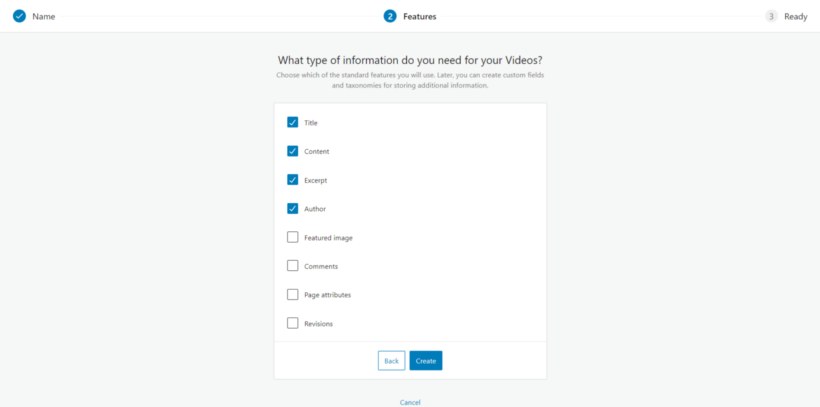
For our tutorial, I’m selecting:
- Title - For adding the video title.
- Content - For adding the video link.
- Excerpt - To add searchable data related to the video.
- Autor - To track the authors associated with each video.
Click on the Create button.
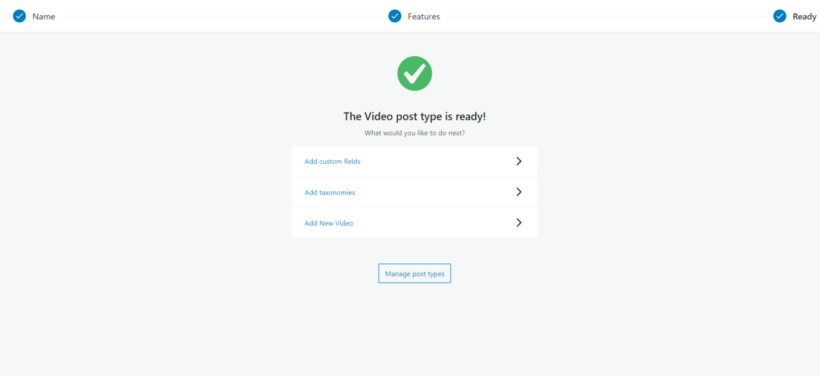
Add custom taxonomies to better organize videos
Let’s quickly add a custom taxonomy to our custom post type. This will help better organize the videos and help the users search and sort the content without any trouble.
- Go to Post Types → Manage.
- Click on the Taxonomies button for the Videos WordPress post type.
- Click on the 'Add New' button to add a new taxonomy.
- Enter the singular and plural names for the taxonomy along with the slug. For example, you can add a Category or Genre taxonomy to help arrange the content better.
- Once it's done, click on the Add taxonomy button.
Adding YouTube videos to the playlist
Now that the Video WordPress post type is ready along with the custom taxonomy, we can start adding videos to our playlist.
Here you have two alternative options to add the videos. It will broadly depend on how you want to display the videos:
Displaying one video per row - In this view, each table row will have one video in the videos column. You can use other columns to add information related to that video. This will create a searchable and sortable responsive table for your viewers to easily find the video they are looking for.
Displaying a video playlist per row - In this setup, each row will display an entire video playlist. The table can display multiple playlists, and this is perfect for scenarios where you have multiple playlists to display on a single page. You can also add extra columns with each playlist row to display additional information related to the video playlists. And here also, the viewers can search and sort the table to find the playlist they want to watch.
Let’s take a look at both methods in detail:
Displaying one video per table row
To display one video per row in a table, we will add the YouTube video link in the new post in the custom post type we created earlier.

This method does not require you to have the video added to a YouTube playlist. Even if the video is not part of a YouTube playlist, it can still be a part of the playlist you create on the website. Let’s see how this is done.
We’ll create a post in the new custom post type – Videos.
- Go to your admin dashboard → Videos → Add New.
- Add the post title. This can be the same as the video title.
- Now copy the embed code from the YouTube video page. To get this code, open the video page and click on the share button. Click on the 'Embed' link and copy the code.

- Paste the embed code in the content area of the post.
- If you’ve added the custom taxonomy to the post type, enter the taxonomy keywords.
- Click on the Publish button.
Repeat the steps above and add more videos. If you wish to add content related to the videos, you can add it in the excerpts section. Any content added here will also help in refining the search results.
Displaying a video playlist per table row
If you have multiple video playlists, you can display playlists in individual table rows. This way, you can display multiple playlists on the same page.
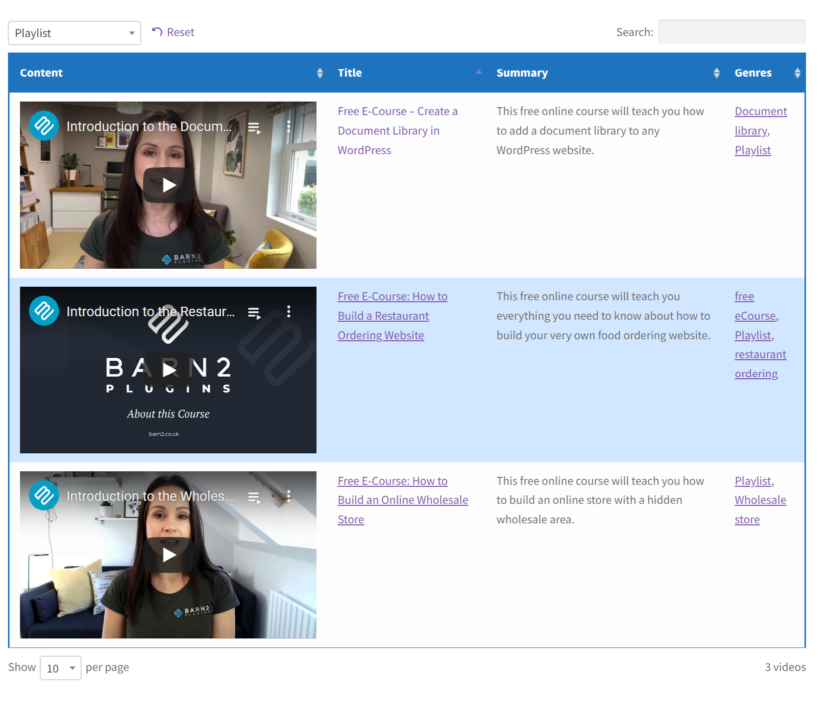
Before you begin, make sure you have playlists created on YouTube that we’ll be displaying on the table.
Firstly, we’ll add a new post to the Videos post type.
- Go to your admin dashboard → Videos → Add New.

- Add the post title. This can be the same as the playlist title.
- Copy the embed code or the link of the playlist you wish to add to the row and paste it into the content area of the new post draft.
- If you’ve added the custom taxonomy to your post type, enter the taxonomy tags.
- Click on the Publish button.
Repeat the steps and add all the playlists you want to add to the table.
Once you’ve added the playlists/video posts to your custom post type, we can use the Posts Table Pro plugin to display it on the website.
Using Posts Table Pro as your WordPress YouTube playlist plugin
Posts Table Pro is designed to display any content on a WordPress website in a responsive table format. This is the best plugin for displaying a YouTube playlist on the website as it comes with advanced search, sort, and filter capabilities to easily navigate through large content libraries.
Here’s why Posts Table Pro is the perfect WordPress YouTube playlist plugin:
- For every video, you can display metadata such as description, title, and tags to help users better understand the video and refine the search.
- You can categorize your playlist to create sub-groups of videos of the same nature.
- With search filters and sorting options, your viewers can efficiently navigate through the playlist and find the one they are interested in.
- You can control how the video playlist looks by customizing the content and the design from the settings option.
Now we know why displaying YouTube videos with a WordPress YouTube playlist plugin is recommended. Let’s jump in and see how you can use and display it on your website.
Installing Posts Table Pro
If you do not have the Posts Table Pro plugin, you can get it here.
- Go to your WordPress dashboard → Plugins → Add New.
- Upload the plugin on the website and click on the Install button.
- Once the plugin is installed, click on the Activate button.
- Then follow the setup wizard instructions to create your first table. Alternatively, you can create a new table at any time by going to Post Tables → Add New.
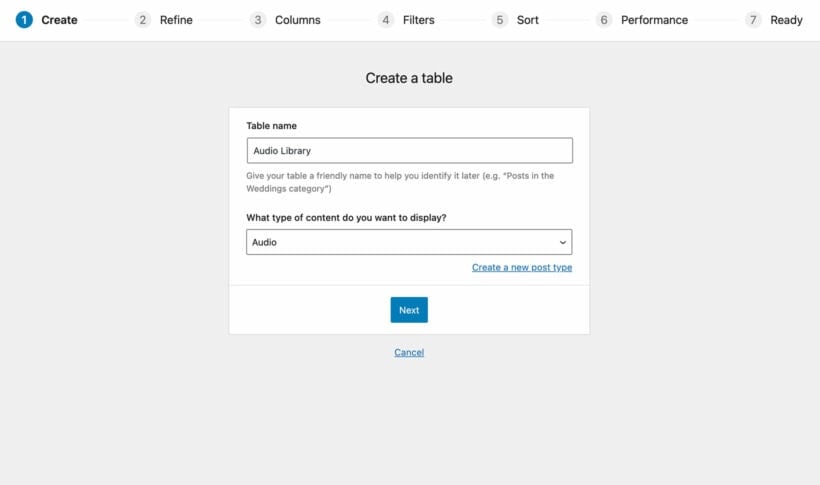
- Name your playlist and choose the post type you want to display. If you want to display videos in your table, you can select the "Videos" post type from the dropdown list.
- Select the video posts you want to display in your playlist. This page will display all the video posts associated with the "Videos" post type, and you can choose which ones to include on your playlist.
- Customize your playlist columns. Select the columns you want to display. To display the video title, video (post content), excerpt, and taxonomy, enter the relevant columns on the "Columns" page. You can also re-order the columns by dragging and dropping the sort icon on the left or the column title.
- Add filters to your playlist to help users narrow down their selections. For example, if you've created a "Genre" taxonomy for your video posts, you can add a filter for that. To add a filter, enable custom filters and select the filters that you want to display above the podcast playlist.
- Customize the sorting options for your playlist. You can set the default sorting option and the sort direction.
Inserting a video table
To display your video content, you just need to insert the table that created in the previous section anywhere on your site.
To do this, either use the Gutenberg editor to insert a 'Post Table' block, or copy the shortcode from Posts Tables → Tables to wherever you want the podcast playlist to appear.
This is what my YouTube video playlist looks like after doing this:

Install the best YouTube playlist plugin today!
With the Posts Table Pro plugin, we created a video playlist display in a well-structured format. With additions such as filters and search, Posts Table Pro has proved to be one of the most efficient methods of creating and displaying content on a WordPress website.
Here’s why Posts Table Pro is perfect for your needs:
- Add playlist with search, filters, and sort features.
- Add video from multiple sources such as YouTube or Vimeo.
- Easily adjust video thumbnails of your youtube content.
- Easy to set up and get started.
- Make a playlist combination of YouTube, Vimeo, and self-hosted videos.
- Reliable support and detailed product documentation
- 30-day no questions asked money-back guarantee.
- Display videos and playlists in a responsive table format.
By following the steps mentioned above, you can display a functional YouTube video playlist on your website in no time.